Cesky Krumlov: Inside one of Europe’s greatest castles
Cesky Krumlov Castle was extravagantly remodelled in the 18th-century. In the first of two articles, John Goodall considers its development and spectacular interiors.
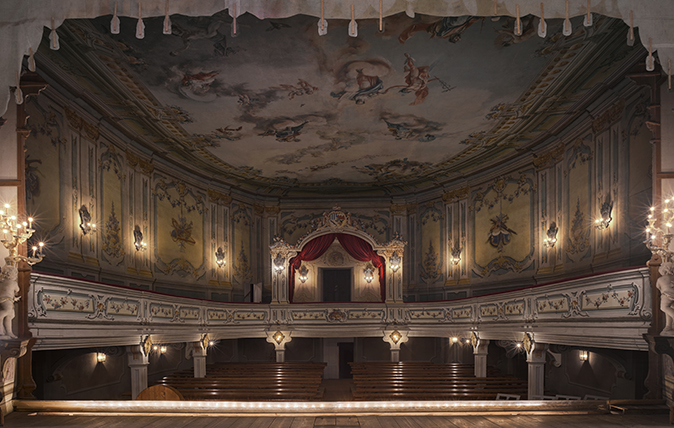

The picturesque Czech town of Cesky Krumlov, set within a tight loop of the River Vltava, makes for an unforgettable sight. Its skyline is dominated by a vast castle that has played a central role in the history of Bohemia. First mentioned in 1240–2, the castle was developed to its present extent by three outstandingly powerful families: the Rosen-bergs from 1302, the Eggenbergs from 1622 and the Schwarzenbergs from 1719.
It occupies a long rocky outcrop that rises along the outside curve of the river. This topography imposes a dramatic, sweeping arc on its massive complex of buildings, which are ordered around a series of five courtyards connected by a single road.
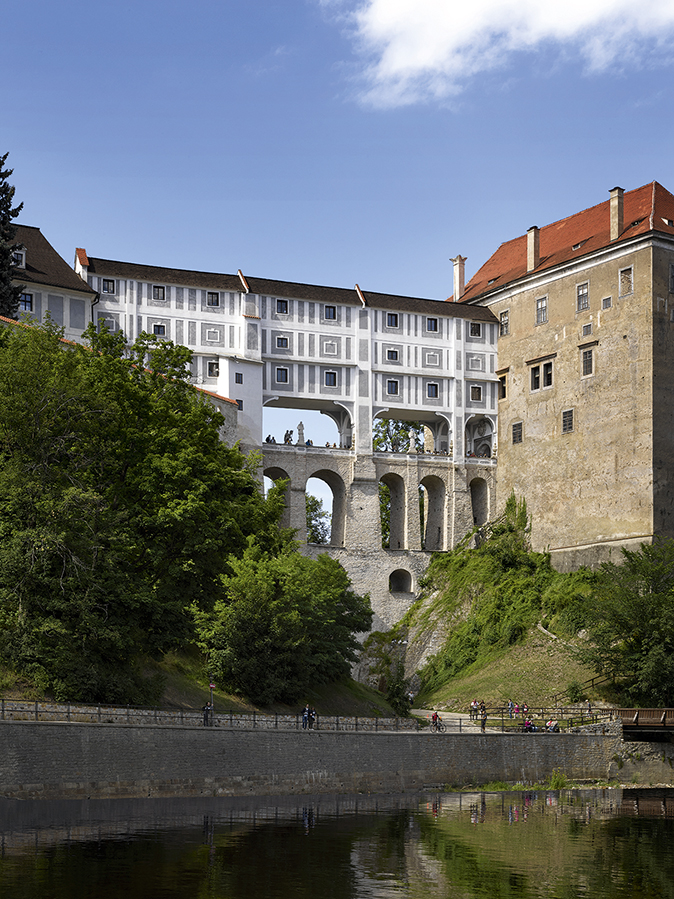
Dominating the lowest two courtyards is a great drum tower crowned by a gallery and spires, the visually defining building of the castle and the town. It commands the principal bridge across the river and, from its balcony, a fanfare is sounded three times a day, a practice dating back to the 18th century. The tower has probably existed since the 13th century and stands at the heart of a small court called the Little Castle.
It was remodelled in its present form in about 1580 by the Swiss-born architect Baldassare Maggi d’Arogno as part of a major reorganisation of the entire castle undertaken by the diplomat and statesman Wilhelm of Rosenberg (d.1592). The tower walls were painted in imitation of masonry by the local artist Bartolomej Beranek, known as Jelinek, in 1590, a scheme much renewed since. Such painted rustication on plaster is found throughout the castle and conceals walls constructed of rubble.
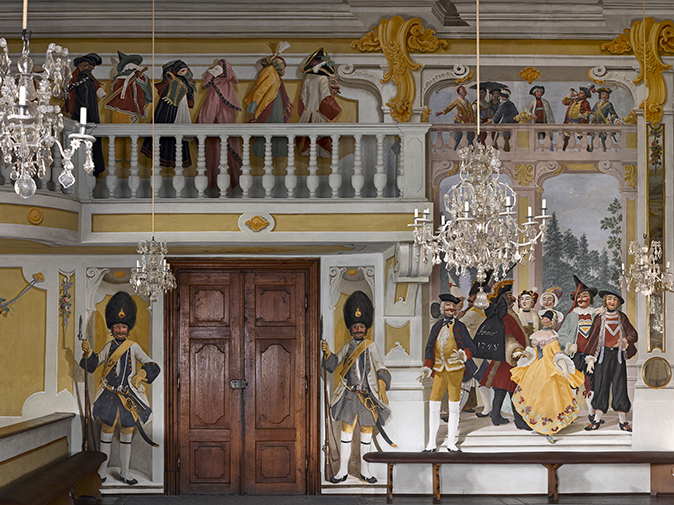
Beneath the tower is the lower castle ditch, which, since the late 16th century, has been the home to a small colony of bears. There is a long medieval tradition of displaying beasts in the moats or entrances of castles (as, for example, the lions at the Tower of London), but this is the only place in Europe where the practice has survived to the present. The choice of beast is significant: the Rosenbergs claimed descent from the Orsini of Rome and adopted the ursina or small bear as their heraldic beast.
Accommodated within the two lower courtyards of the castle are its ancillary buildings. These include a salt house and prison and, immediately beneath the tower, the mint, latterly the headquarters for the castle hunt. There is besides a buttery and the house of the castle administrator or Burgrave.
It was completed in about 1578, with its exterior painting executed by the Dutch artist Gabriel de Blonde, who also worked on the castle apartments. This building later housed an armoury and the barracks of the Schwarzenberg Guard, a body of grenadiers raised in 1742, which survived until 1949. Today, it serves as a museum and public library.
Sign up for the Country Life Newsletter
Exquisite houses, the beauty of Nature, and how to get the most from your life, straight to your inbox.
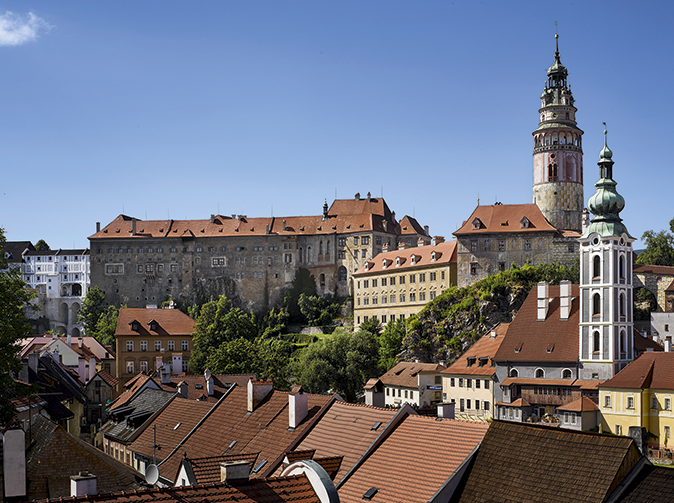
From the lower two courtyards, the route into the castle rises steeply through a gateway into a long tunnel partly paved in timber. This approach, created in the 1570s, curves through the living rock and emerges into the first of two interconnected courtyards that form the Upper Castle. Both the courtyards are strikingly tall and their internal faces decorated with painted rustication and Classical figures, again renewed schemes by de Blonde of the late 16th century.
They accommodate the principal castle apartments. These are arranged on three levels, with winter rooms raised above a vaulted basement and insulated from above by lofty chambers for summer use. The Upper Castle is a complex architectural palimpsest, but its bones, including the cellars and the Chapel of St George (first mentioned in 1334), are medieval. All its most important domestic interiors face south and enjoy fine views over the town.
Passing through another tunnel beyond these courtyards, the road is carried over a deep ravine by the spectacular Cloak Bridge, formed like an aqueduct with seven tiers of arches. A bridge, probably of wood, is documented here from the 15th century, but the present structure was completed in 1777. This connects the main castle on four levels (if you include a maintenance passage) with the fifth courtyard – including the theatre, the stables and the riding school – as well as the gardens beyond.
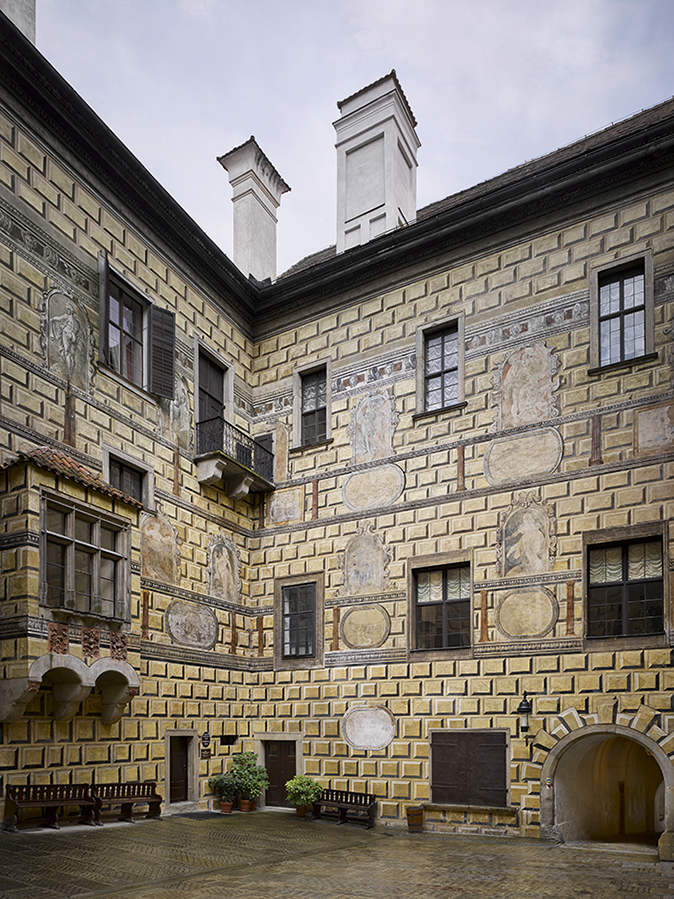
Visitors to the main apartments of the castle today see them presented in three periods of their history: the 16th, 18th and 19th centuries. This treatment, based on research into the surviving castle inventories, does justice to the rich and varied collections held within the building and its deep history. The present form of the castle, however, was broadly determined in the 18th century.
In 1719, the castle passed by inheritance from the Eggenbergs into the hands of Adam Franz of Schwarzenberg, a courtier of the Emperor Charles VI, who became Duke of Cesky Krumlov. While out hunting in 1732, he was fatally wounded by his master (the clothes he was wearing, complete with a bullethole, still survive). To make amends, Charles placed the entire Schwarzenberg estate and its heir, the 10-year-old Joseph Adam, under imperial protection.
In 1741, at the age of 19, the young Duke came into his Austrian estates and married Maria Theresa of Liechtenstein, a marriage that further augmented his enormous wealth. Four years later, he took control of his German properties as well and, in 1746, secured the descent of his title as a prince to all his children.
The Prince’s tastes were shaped both by his travel – notably to Italy – and by the Imperial court. From 1745, and in conjunction with other architectural projects, he began to reorganise Cesky Krumlov and its gardens with expertise imported from Vienna. His retained architect, Andrea Altomonte, and the sculptor Jan Antonin Zinner, for example, both came from Vienna and were engaged in his first project, the construction of a new winter riding school beyond the Cloak Bridge in 1744–6.
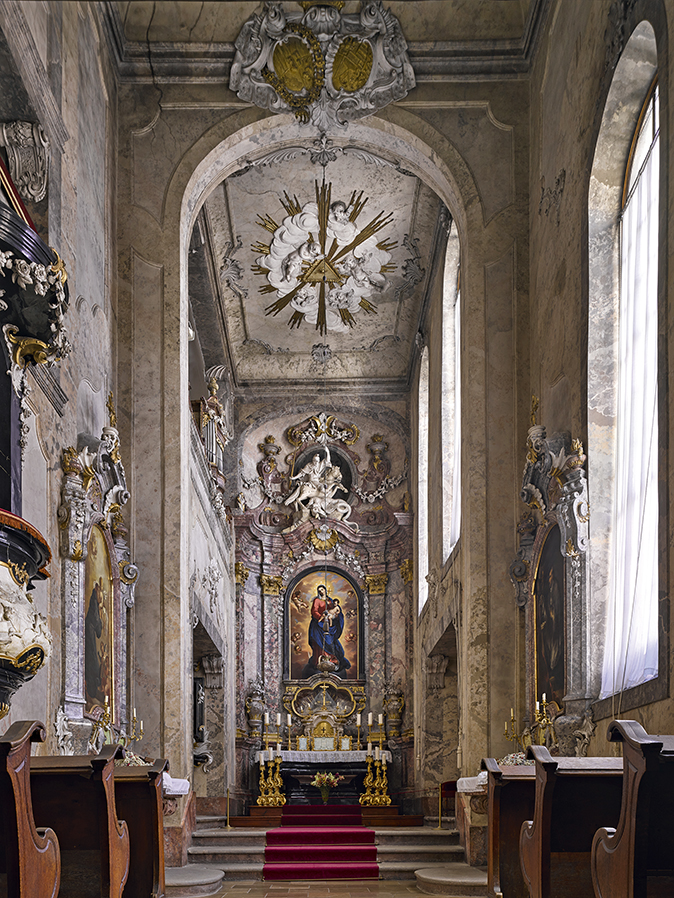
In planning his changes, the Prince was obliged to work within the constraints imposed both by the topography of the site and the two courtyards of the existing castle. To a striking degree, in fact, he preserved the shell of the house he had inherited. Presumably, he felt that its appearance of antiquity reflected well on his dignity. Picturing how the castle interiors unravelled to a visitor in the 1760s requires an effort of imagination, but it helps explain how the building was used.
The Prince created a new formal entrance stair to his apartments at the juncture of the two courtyards in the Upper Castle. Accessible from this rising stair was the chapel, remodelled in 1750–3, which inherits tall and narrow proportions from the volume of its medieval predecessor. The walls and ceilings are entirely covered in scagliola to suggest a polychrome marble finish and the altar is flanked by vases of flowers in the same material. There are tiers of galleries connected to the family apartments at one end of the chapel.
At the head of the stair on the second floor was the waiting room, its walls hung with maps and paintings of other houses and castles owned by the Scharzenberg family. In the 18th century, there was also a billiard table, presumably to help petitioners pass the time. From this opened an enfilade of interiors with a dining room, drawing room and bedchamber. These were hung with fabrics and tapestries from the celebrated family collection. The only pictures they contained were a pair of family portraits.
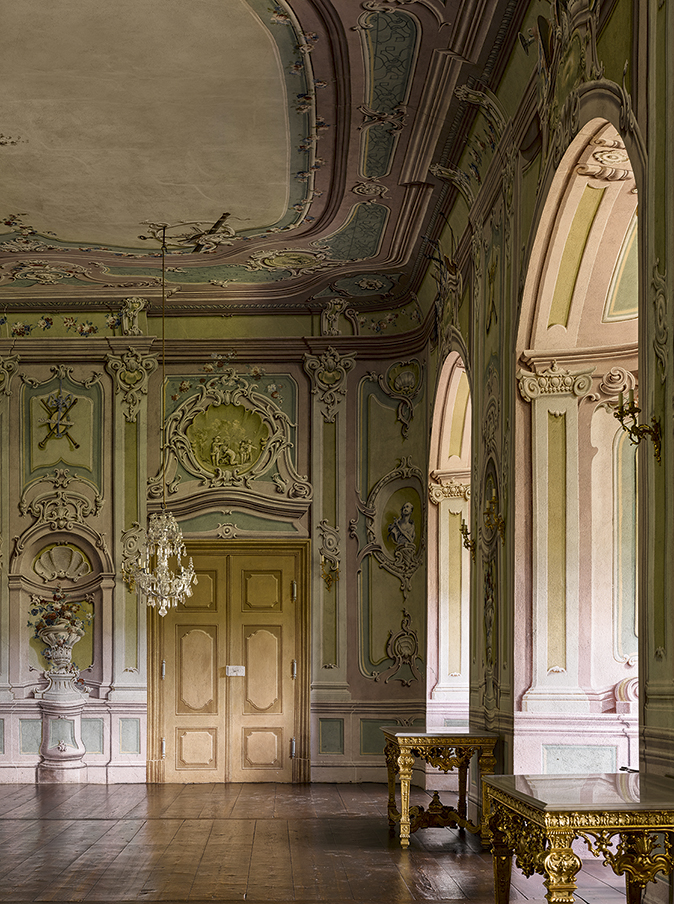
Opening off the bedchamber was a small oratory as well as a closet decorated in the Chinese fashion in 1757. There was also a door from it to a picture gallery that crossed the full width of the castle. This in turn gave access to the topmost passage of the Cloak Bridge over the castle ditch. Divided into two sections, this extraordinary corridor, which runs gently uphill, provided private access to both the buildings on the far side of the moat and the castle gardens beyond. The corridor was closed with several iron doors, either for security or to prevent the spread of fire.
It is one of the curiosities of the castle, and a legacy from the physical constraints within which it was remodelled, that the Prince’s private apartment is effectively separate from the principal entertaining chambers: two halls and – connected with them across the bridge – a theatre (completed, as we shall see next week, in 1767). These striking interiors constitute the chief wonders of the castle today and were evidently remodelled in order to operate as a grand suite for entertainment.
The halls were accessible from a shared staircase landing and are roughly of equal size. One of these was a dining chamber, with kitchens and services at one end, the so-called Hall of Mirrors painted in 1768 by two Viennese artists also employed in the theatre, Leo Märkel and Hans Wetschel.
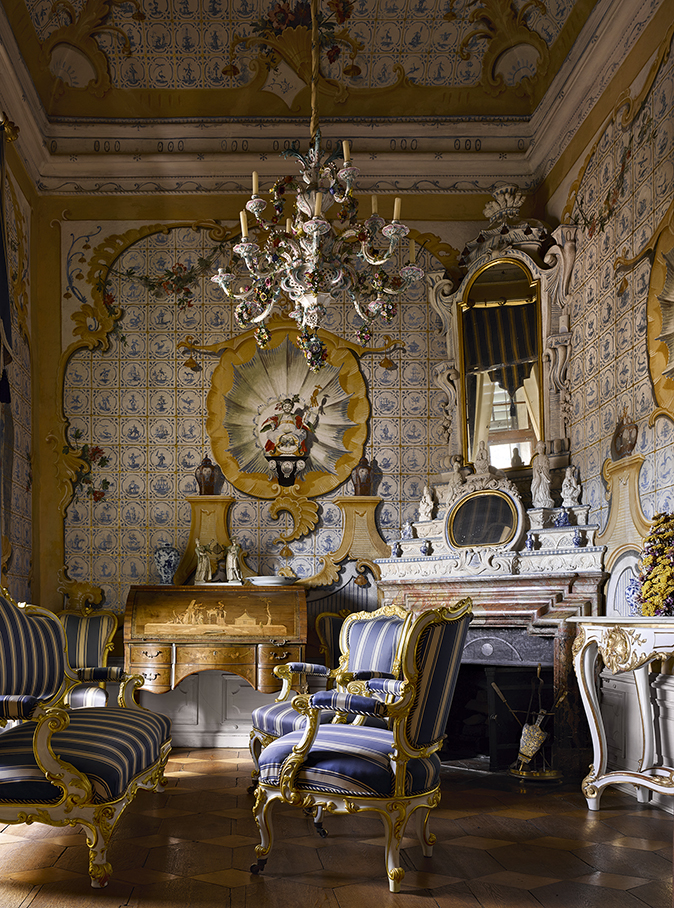
The other, the Masquerade Hall, is an interior without exact European parallel. It was painted in the course of six months in 1748 by one Joseph Lederer and two assist-ants. He was brought to Cesky Krumlov from Vienna, but nothing is otherwise known about his life or other work. It is likely that he died by 1750 and that he trained his successor, Frantisek Jakub Prokys from Slany in Bohemia.
The walls are decorated with life-sized figures in masquerade and Commedia dell’arte dress, such as Harlequin and the miserly Pantalone. The decoration was clearly intended to echo the entertainments held here and to draw the living audience into the scene represented about them. To increase the confusion between art and reality, oval mirrors at head height round the room reflect the faces of any onlookers and project them into the scheme.
Two grenadiers stand guard beside the entrance and the musicians’ gallery above is painted with costumes on pegs, instruments and a sheet of music. On every side, the hall opens out into a garden landscape, with figures parading on raised walkways or on the edge of the room in spectacular dress and masks.
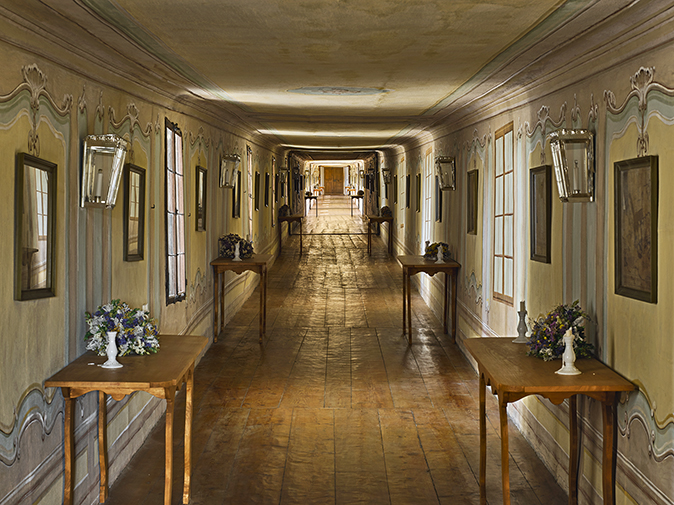
Overlooking the whole space is a balcony accessible from the Prince’s bedchamber. Represented within it is a costumed group, including the Prince and Princess, involved in a game of cards. As befits this playful room, one of the players in this life-sized scene is conniving with another member of the party to cheat at the game by using a mirror to examine an opponent’s hand.
It is not just the scale and vigour with which this scene of revelry is evoked that makes the hall so remarkable. The characters presented here were also active on the stage of the theatre that operated just across the bridge; some of the costumes depicted here actually survive in the theatre wardrobe. They include the waistcoat worn by the painter himself, who is shown with a cup of coffee in one embrasure close to the door.
It is to this remarkable theatre – recently restored and the most complete example of its kind to survive in Europe – that we will turn our attention next week.
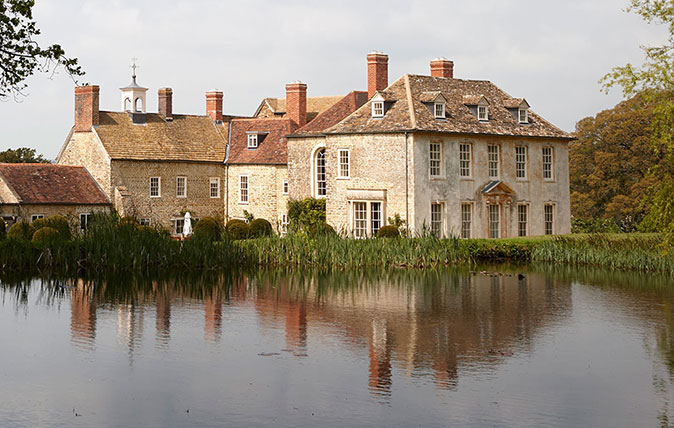
Credit: Shanks House, Somerset (©Paul Highnam/Country Life)
Shanks House: A model restoration of a magnificent Georgian home
The exemplary restoration of this magnificent house has reintegrated a complex building into a single and coherent modern home, as
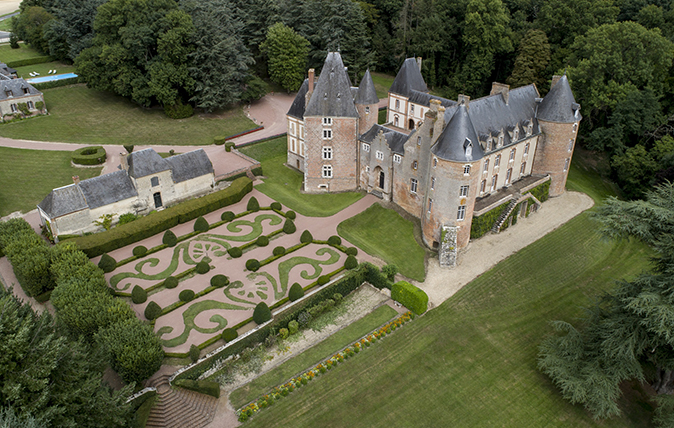
This 'baby Versailles' is up for auction – and there's no reserve price
Château de Blancafort is up for auction with no reserve price.
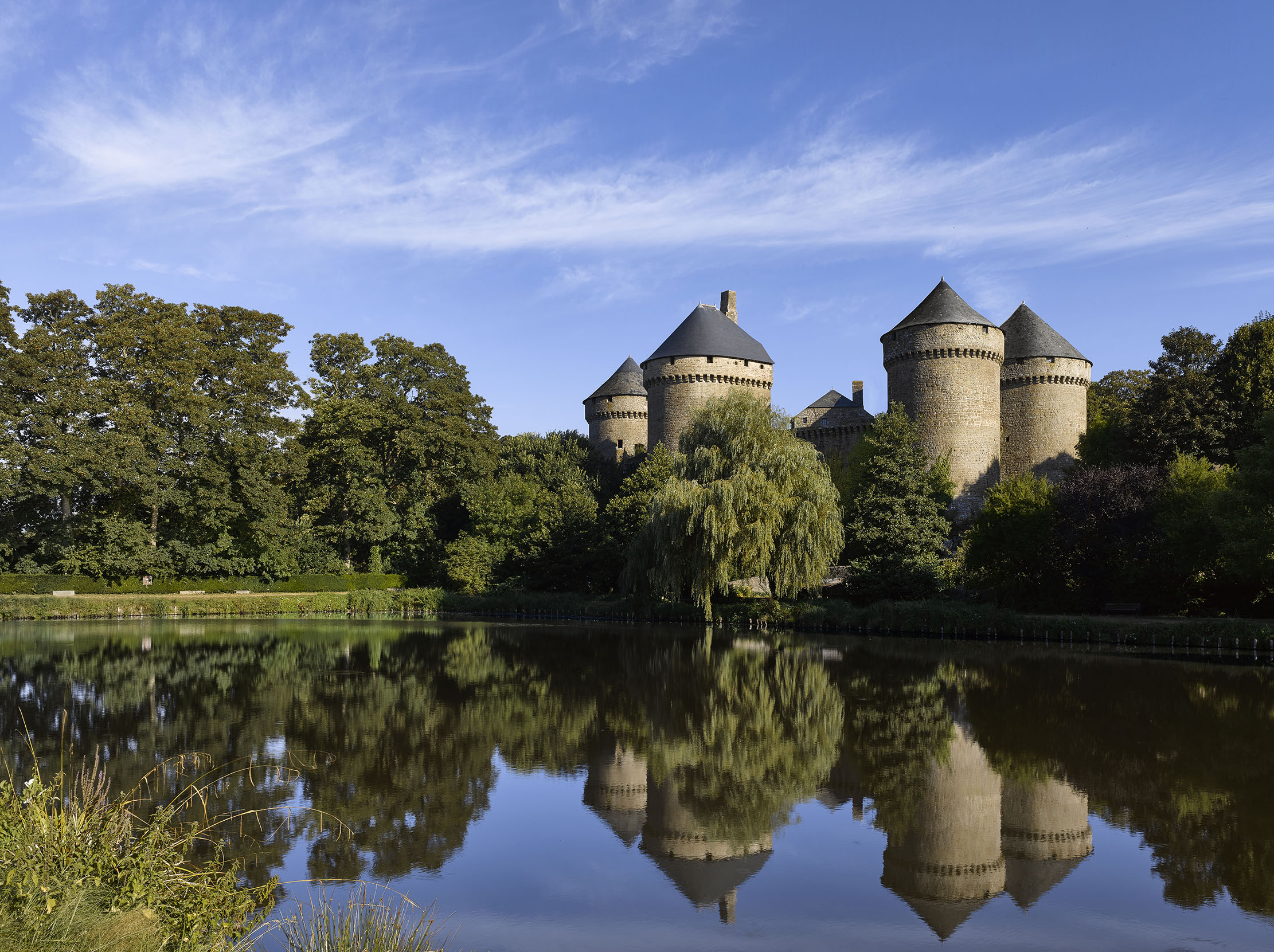
Château de Lassay: The castle of Bluebeard’s widow
This magnificent French castle has a remarkably colourful history, as Desmond Seward explains.

John spent his childhood in Kenya, Germany, India and Yorkshire before joining Country Life in 2007, via the University of Durham. Known for his irrepressible love of castles and the Frozen soundtrack, and a laugh that lights up the lives of those around him, John also moonlights as a walking encyclopedia and is the author of several books.
-
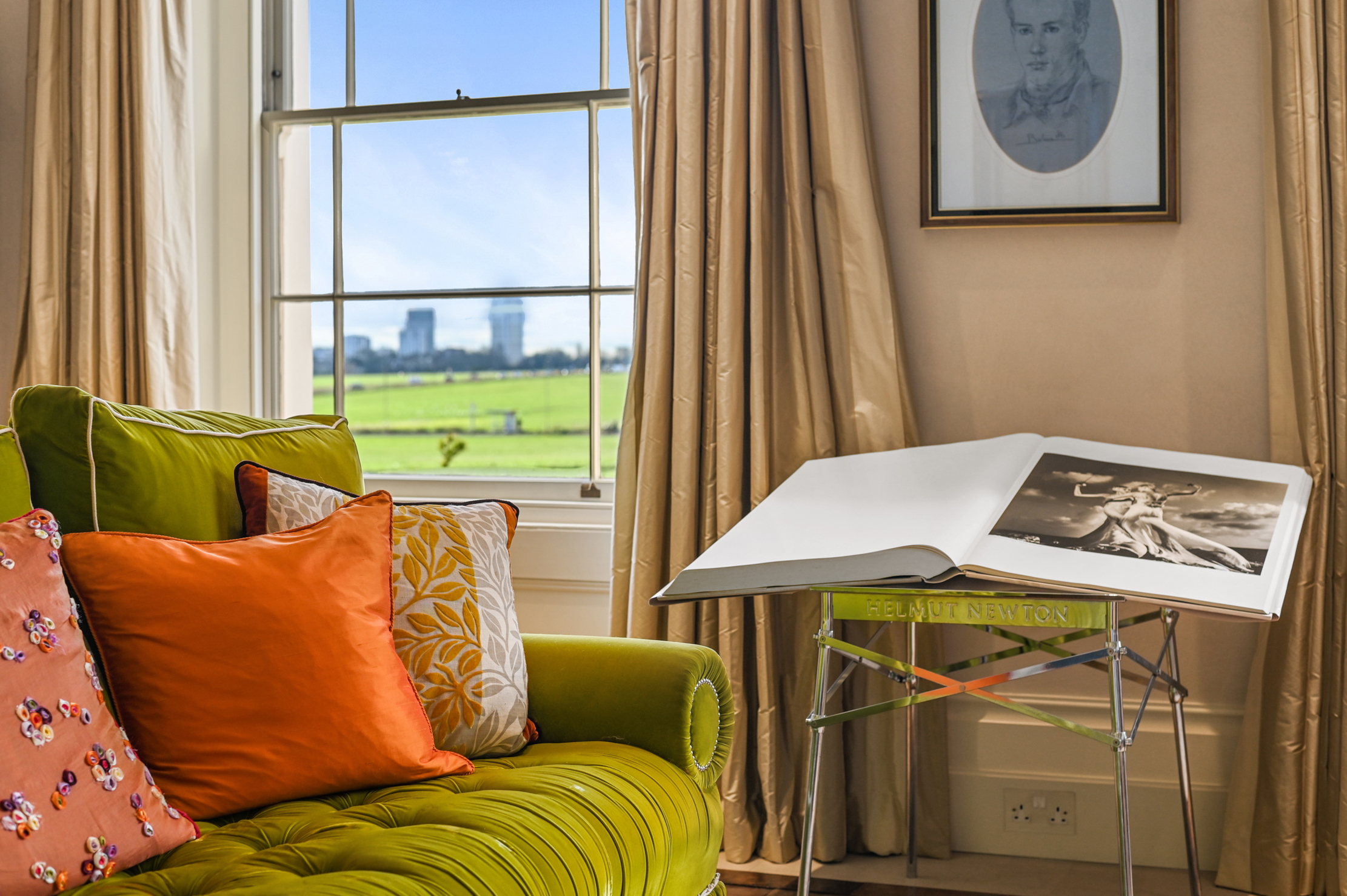 A rare opportunity to own one a family home on Vanbrugh Terrace, one of London's finest streets
A rare opportunity to own one a family home on Vanbrugh Terrace, one of London's finest streetsThis six-bedroom Victorian home sits right on the start line of the London Marathon, with easy access to Blackheath and Greenwich Park
By James Fisher
-
 Materials, textures, construction, expression: A Brutalist watch on your wrist
Materials, textures, construction, expression: A Brutalist watch on your wristLuxury watchmakers are seeking to bridge the gap between two contrasting styles, with exciting results.
By Chris Hall
-
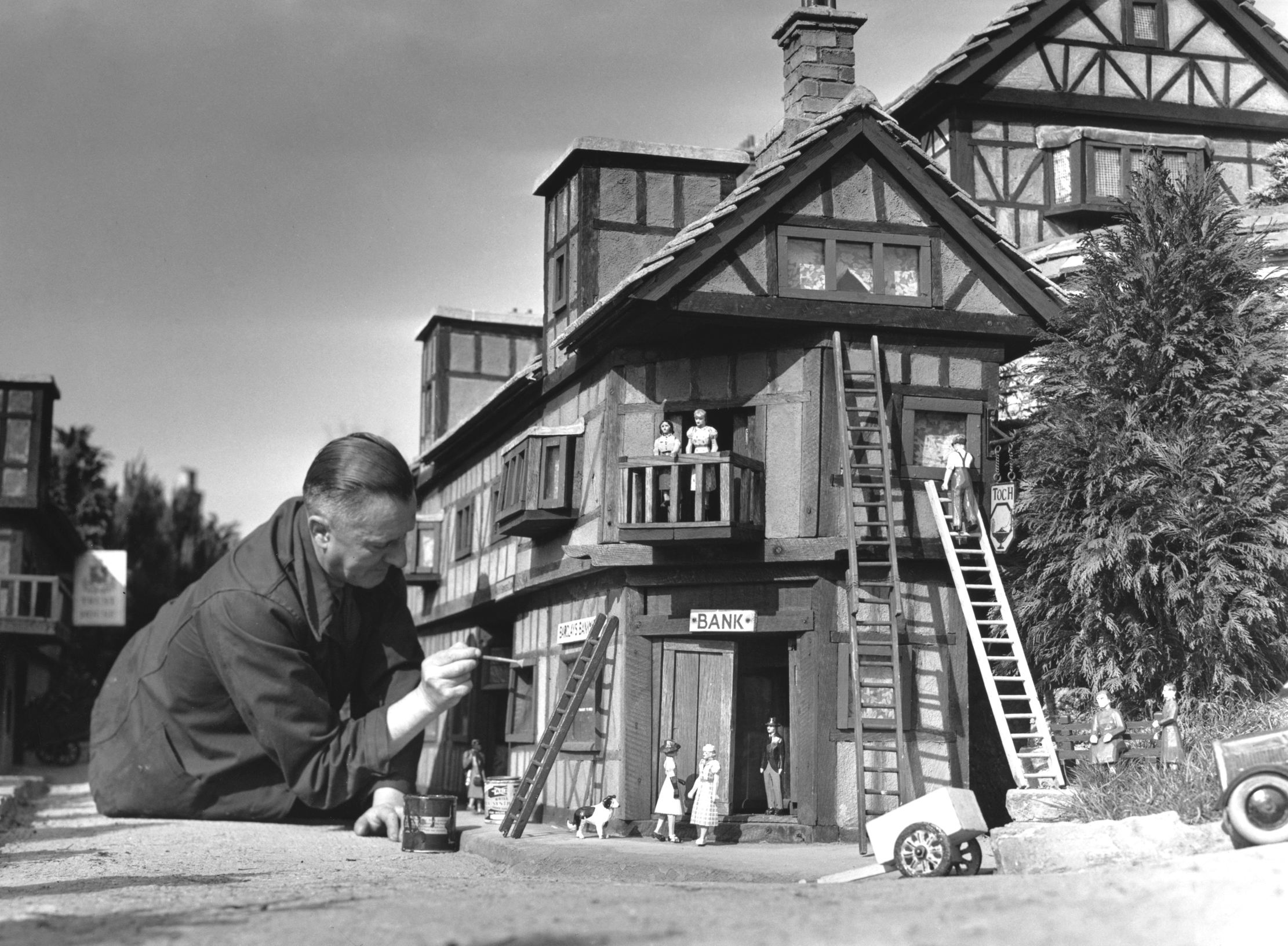 Life in miniature: the enduring charm of the model village
Life in miniature: the enduring charm of the model villageWhat is it about these small slices of arcadia that keep us so fascinated?
By Kirsten Tambling
-
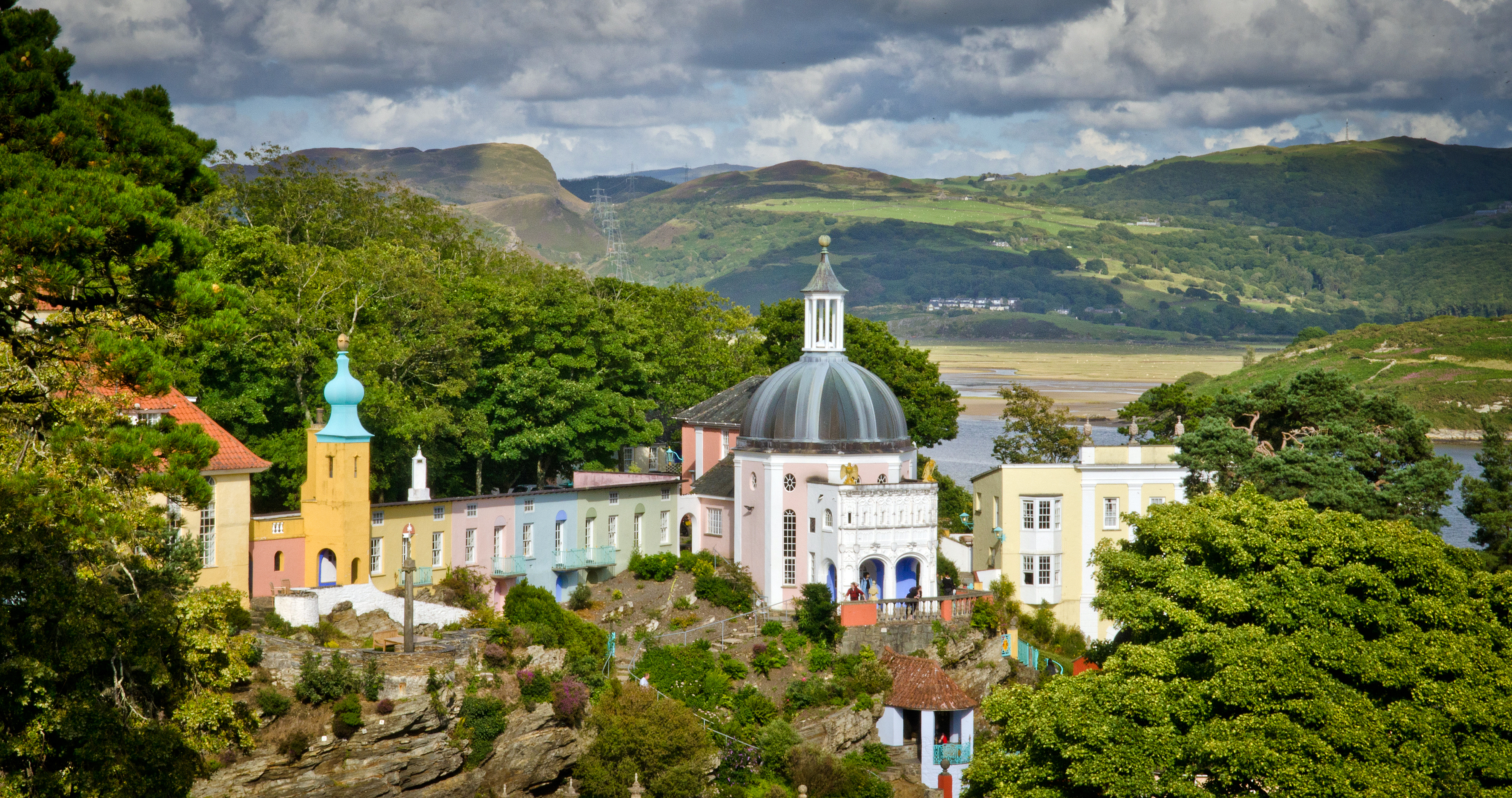 ‘If Portmeirion began life as an oddity, it has evolved into something of a phenomenon’: Celebrating a century of Britain’s most eccentric village
‘If Portmeirion began life as an oddity, it has evolved into something of a phenomenon’: Celebrating a century of Britain’s most eccentric villageA romantic experiment surrounded by the natural majesty of North Wales, Portmeirion began life as an oddity, but has evolved into an architectural phenomenon kept alive by dedication.
By Ben Lerwill
-
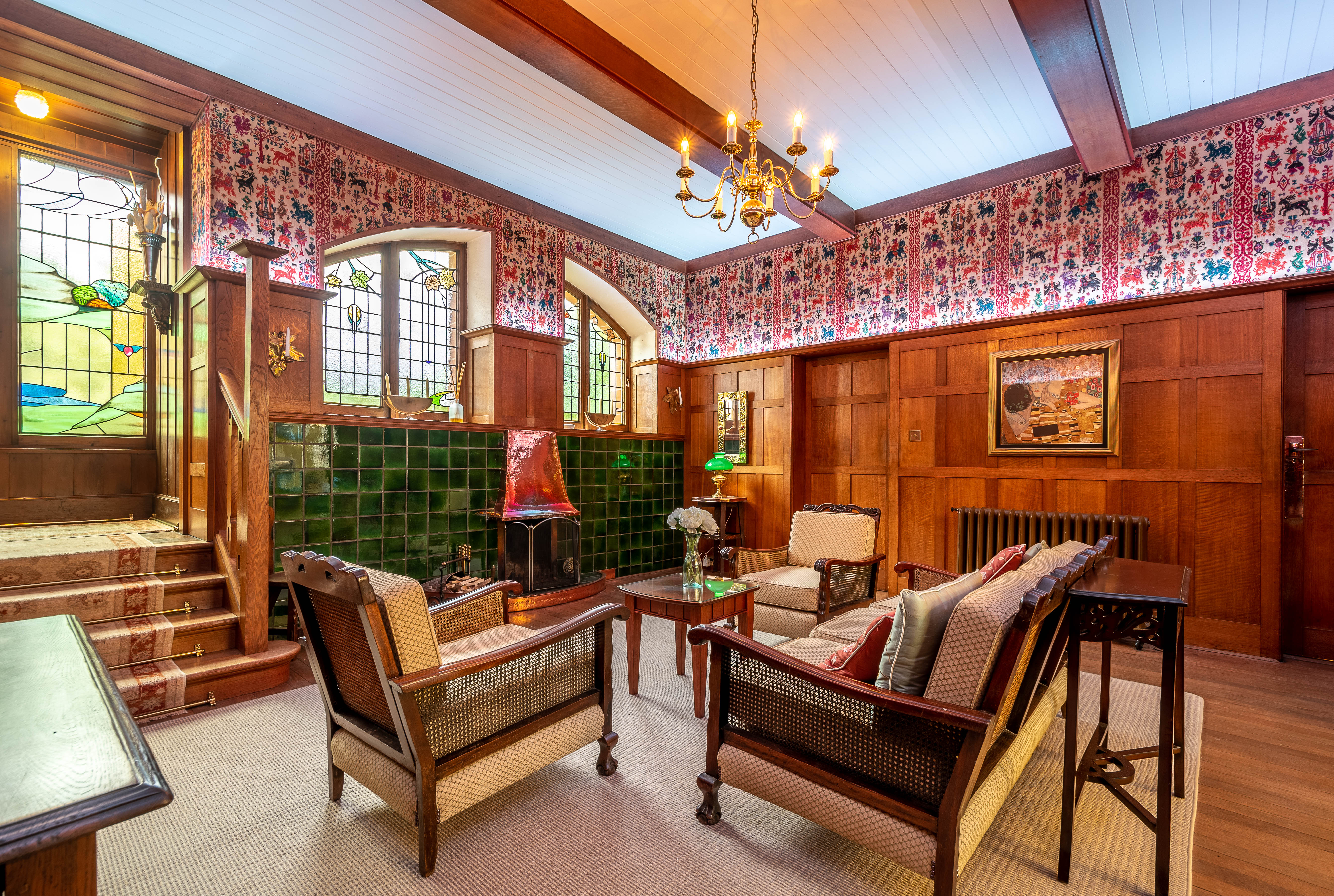 Seven of the UK’s best Arts and Crafts buildings — and you can stay in all of them
Seven of the UK’s best Arts and Crafts buildings — and you can stay in all of themThe Arts and Crafts movement was an international design trend with roots in the UK — and lots of buildings built and decorated in the style have since been turned into hotels.
By Ben West
-
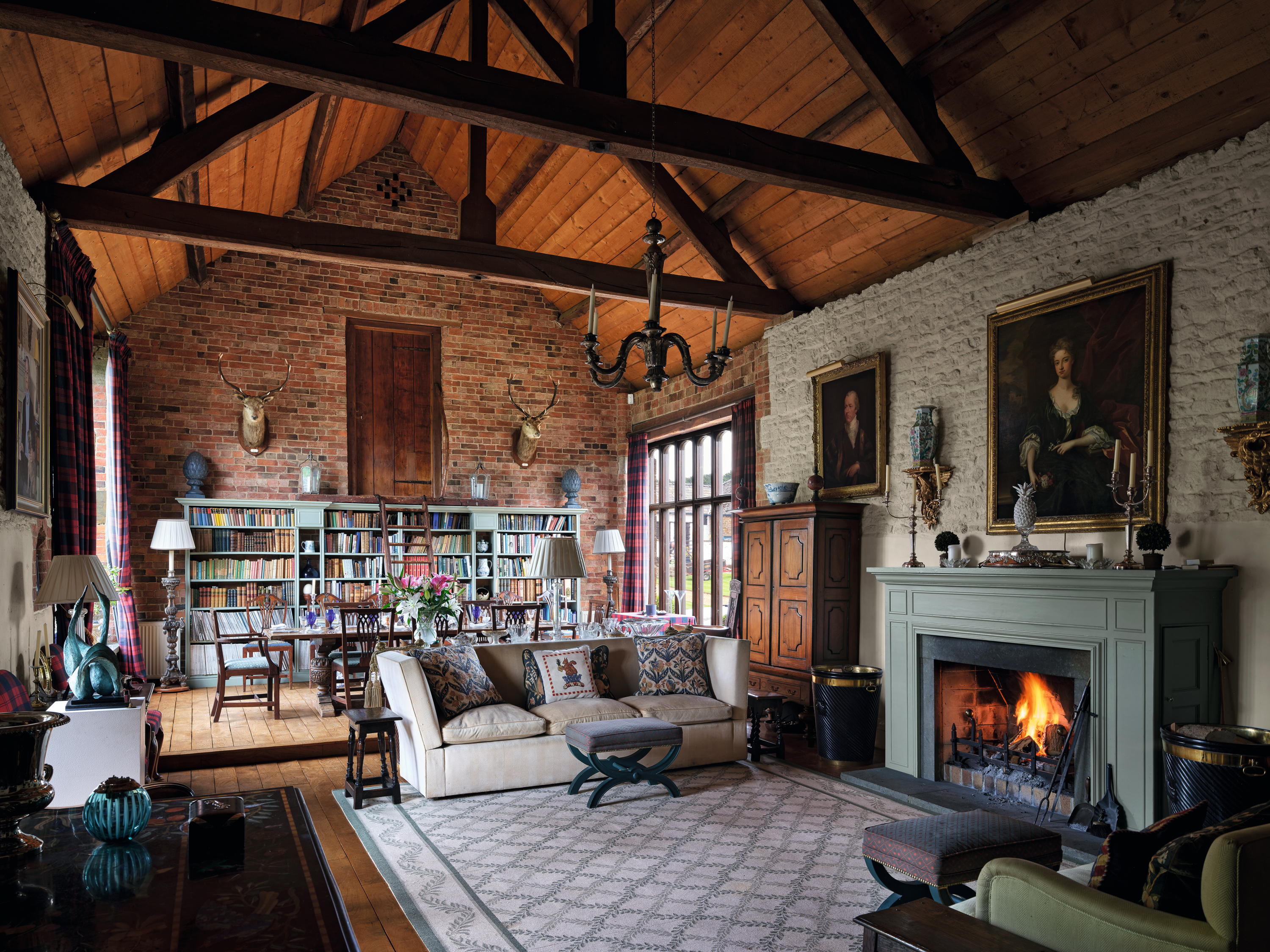 High Wardington House: A warm, characterful home that shows just what can be achieved with thought, invention and humour
High Wardington House: A warm, characterful home that shows just what can be achieved with thought, invention and humourAt High Wardington House in Oxfordshire — the home of Mr and Mrs Norman Hudson — a pre-eminent country house adviser has created a home from a 300-year-old farmhouse and farmyard. Jeremy Musson explains; photography by Will Pryce for Country Life.
By Jeremy Musson
-
 Sir Edwin Lutyens and the architecture of the biggest bank in the world
Sir Edwin Lutyens and the architecture of the biggest bank in the worldSir Edwin Lutyens became the de facto architect of one of Britain's biggest financial institutions, Midland Bank — then the biggest bank in the world, and now part of the HSBC. Clive Aslet looks at how it came about through his connection with Reginald McKenna.
By Clive Aslet
-
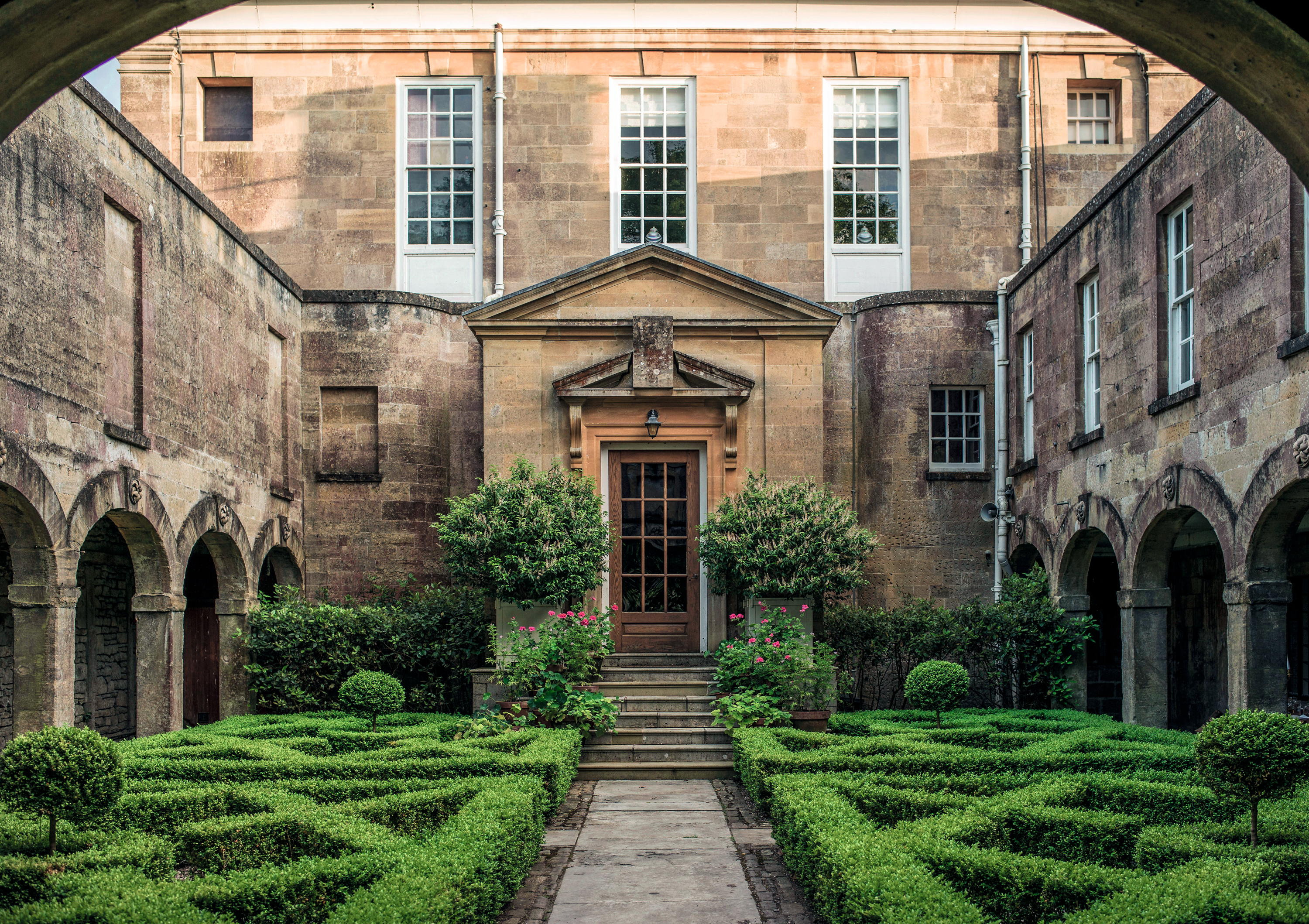 'There are architects and architects, but only one ARCHITECT': Sir Edwin Lutyens and the wartime Chancellor who helped launch his stellar career
'There are architects and architects, but only one ARCHITECT': Sir Edwin Lutyens and the wartime Chancellor who helped launch his stellar careerClive Aslet explores the relationship between Sir Edwin Lutyens and perhaps his most important private client, the politician and financier Reginald McKenna.
By Clive Aslet
-
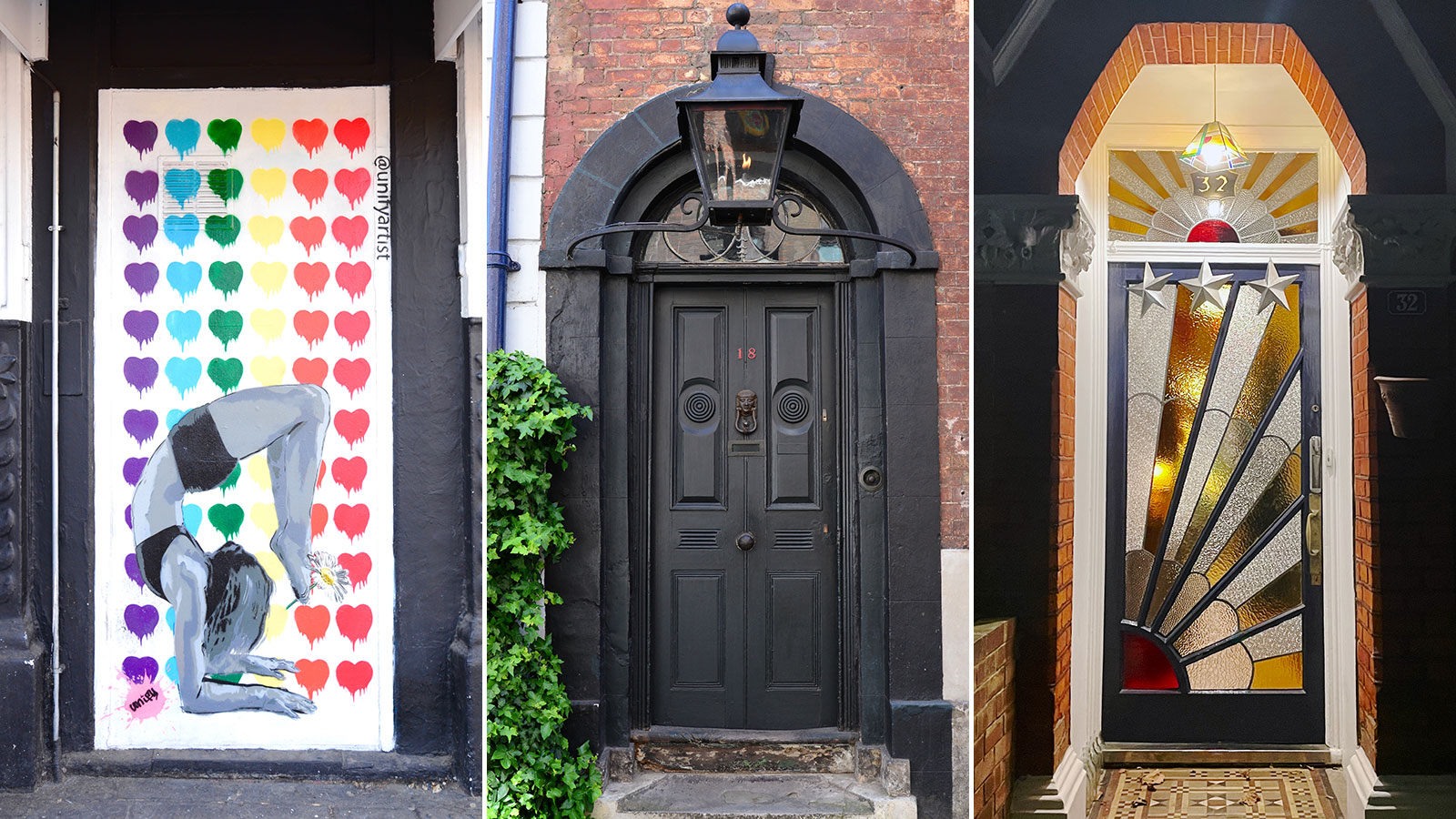 Cath Harries — The photographer on a 15-year quest to find the most incredible doors in London
Cath Harries — The photographer on a 15-year quest to find the most incredible doors in LondonBy Toby Keel
-
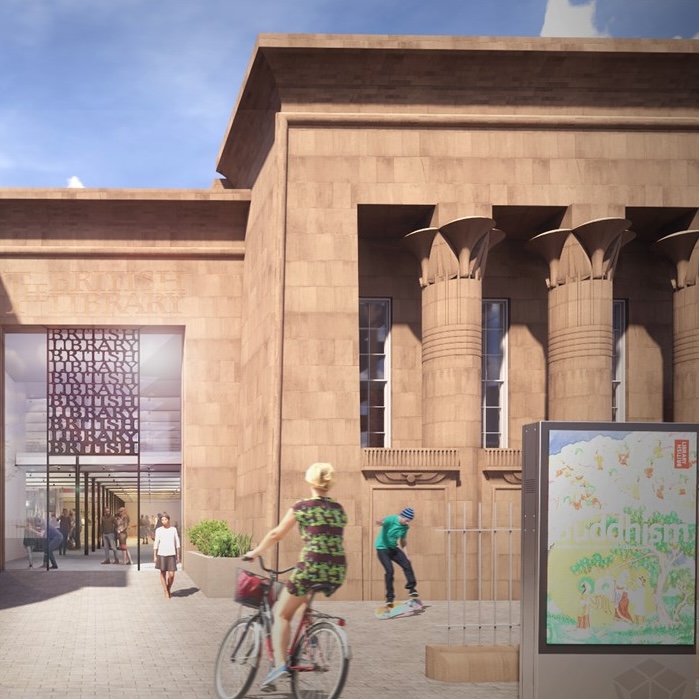 The extraordinary Egyptian-style Leeds landmark hoping to become a second British Library — and they used to let sheep graze on the roof
The extraordinary Egyptian-style Leeds landmark hoping to become a second British Library — and they used to let sheep graze on the roofThe project has been awarded £10million from the Government, but will cost £70million in total.
By Annunciata Elwes